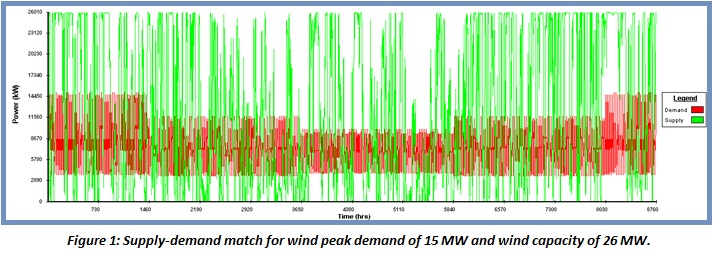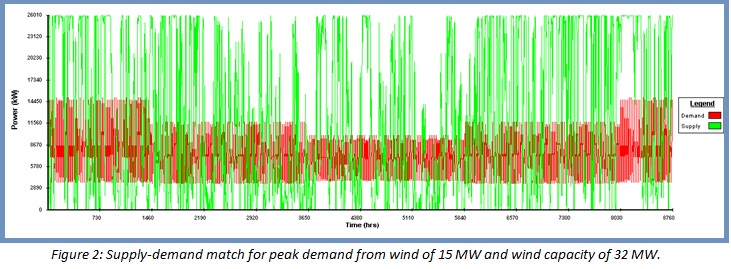
OVERVIEW
An important aspect of the project is to estimate the surplus electricity that could be available to the district heating scheme. The capability of the electrode boiler working in partnership with the thermal store to provide heating to the buildings reliably is heavily reliant on the quantity of surplus electricity that can be expected.
This section of the webpage will detail the possible supply and demand of wind power on the main land of Orkney which has been established from our research and a supply and demand software called Merit.
RESULTS
First of all, the peak in the mainland is estimated to be 20 MW, knowing that the winter peak demand in Orkney is 32 MW. (Scottish and Southern Energy, 2004)
However, this peak demand is supplied not only by wind generation, but also by other energy systems, both renewable and conventional (wave energy, diesel generator, etc). For the purpose of this project, it has been assumed that a base load is covered by these systems and that the demand to be supplied by the wind farms is 15-18 MW. Therefore, the supply-demand match simulation has been carried out with both 15 and 18 MW for wind peak demand values.
Additionally, future planned wind farms were taken into consideration, in addition to the actual ones to predict the surplus electricity that will be available in the near future. According to our research there is currently 26 MW of wind capacity in the island, but adding future planned wind turbines increases this value to 32 MW, hence the wind capacity has been estimated to be from 26 to 32 MW.
The wind turbines currently installed on the main land of Orkney along with the planned wind turbines are summarized in the table below:

With all these estimations, four surplus scenarios have been built. This gives a better understanding of the system and allows us to work in ranges in order to provide more realistic results for a dynamic study like this.

The supply-demand representations given by the software for the four different surplus conditions are shown below. These supply-demand profiles were later used to extract surplus profiles for the district heating schemes. This was achiveed by exporting the results into an excel file and subtracting the supply and demand values for every hour of the year. These surplus profiles were then used as a supply profile within Merit to simulate both district heating scenarios. This is explained further in the thermal storage section of the case study which can be accessed using the links above.




References:
- Scottish and Southern Energy. (2004). Facilitate Generation Connections on Orkney by Automatic Distribution Network Management.
- Renewable UK Webpage (2012). Obtained from http://www.bwea.com/ukwed/operational.asp
- Interactive Map of Renewable and Alternative Energy Projects in th UK. (2012). Obtained from http://www.renewables-map.co.uk/index.asp?Status=1